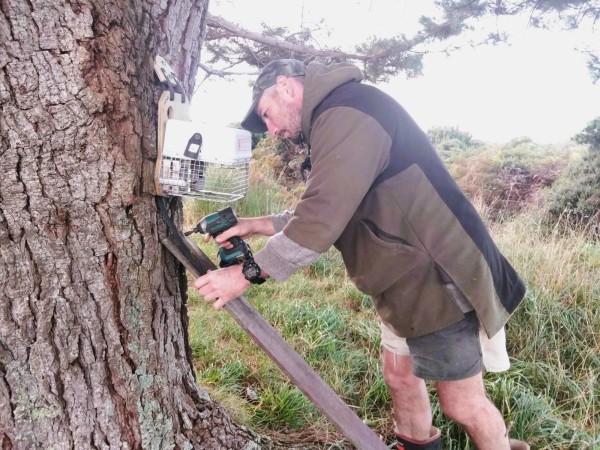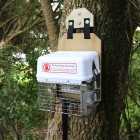Sponsor a Trap
Sponsor a trap to help us fill the trap network covering 7500ha in the northeast of Rēkohu/Wharekauri. We also need lure, materials, and other hardware to make the trapping network run smoothly. This is the first step of Predator Free Chathams.
Help protect and restore the Chathams
You – or your organisation, or a group together – can help us protect our unique environment by sponsoring an AT220 trap.

Paddy, our star volunteer, getting help from his dad to service an AT220.
A donation of $565 covers the purchase, delivery, and basic maintenance of a high-tech AT220 trap. These traps are proven to be effective on our target predator species, have automatic functions that mean maintenance is low, and have mechanism that help reduce bycatch. They also last a long time.
In return, we’ll let you know the location of your trap, send you a photo of it on site, and give you updates on the difference it’s making.
Sponsor a trap now by direct bank deposit, and email info@chathamrestorationtrust.org.nz to let us know.
- Account Name: C I Landscape Restoration Trust
- Account Number: 06-0851-0526713-50
- Residential Address: 13 Waitangi Tuku Road, Chatham Islands 8016
- Bank's full beneficiary name: ANZ Bank New Zealand Limited
- SWIFT code/BIC: ANZBNZ22
- Particulars: Surname, First Name
- Reference: Sponsor a Trap

Help with hardware
If you can’t sponsor a trap right now, a smaller donation helps us get the trap network running and ensure it can keep going! Donations go towards lure, wood and materials for putting the traps in place, and other hardware.
The data about what the traps catch and the difference they make will be publicly available, so you'll be able to see how you've contributed to our project.
Make a donation to the same bank account, and flick us an email so we know where it's come from.
What you’ll be protecting
The north east of the island, where we’re beginning Predator Free Chathams, is a microcosm of the Chathams. It’s a mix of habitats, forest remnants, wetlands, fresh water lakes, sandy beaches, and rocky shores.
Numerous breeding and migratory species are found here, including banded dotterels, oystercatchers, and Chatham and Pitt shag colonies. Tūī and parea are regularly sighted here and trying to colonise, but they’re struggling due to predators. There are also lots of endangered plants, like soft speargrass, kopakopa/Chatham Island forget-me-not, sow thistle and other coastal turf species.
The area also includes the township of Kaingaroa, and sites of cultural significance.
Te Whanga mouth - Hikurangi Channel and Waikawa Island. Image: Cornelia Vervoorn, DOC
How sponsoring a trap works
- You donate to sponsor an AT220 trap, or donate to support the trapping network.
- When enough traps have been sponsored, we’ll put in a bulk order to be shipped to the Chathams. We’ll email you when this is happening, and send you a link to the webpage where we’ll post updates.
- When the traps arrive, we’ll put them out and email you with the location of the trap you sponsored, plus a photo of it. If you like, we can also write your name or your organisation’s name on the trap.
- When we check the traps, we’ll update the data on the webpage. This will include information like the number of different predators it’s caught.
- We’ll send out an end-of-year roundup email about how the Predator Free Chathams project is going, including impact the traps have made for this part of the island.
If you have any questions, please contact us at info@chathamrestorationtrust.org.nz. You can also reach us by sending a message on our Facebook page.


